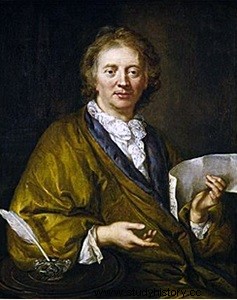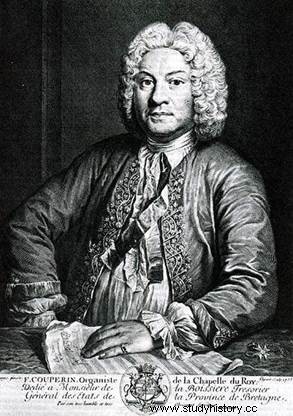 François Couperin (1668-1733) is a French composer and one of the great figures of French Baroque music. The “Couperins” are one of the greatest families of French musicians of the 17th and 18th centuries. François is its most illustrious member, becoming one of the two greatest masters of the harpsichord in France, by the number and above all the quality of his works. He therefore excels in secular music on the harpsichord, during the Evenings at the King's Apartments, but we would be unforgivable if we forgot his sacred music and in particular his masterful Lesson in Darkness, a work of vocal music intended for the liturgy of Holy Week.
François Couperin (1668-1733) is a French composer and one of the great figures of French Baroque music. The “Couperins” are one of the greatest families of French musicians of the 17th and 18th centuries. François is its most illustrious member, becoming one of the two greatest masters of the harpsichord in France, by the number and above all the quality of his works. He therefore excels in secular music on the harpsichord, during the Evenings at the King's Apartments, but we would be unforgivable if we forgot his sacred music and in particular his masterful Lesson in Darkness, a work of vocal music intended for the liturgy of Holy Week.
The life of François Couperin
François Couperin was born in November 1668 in Paris. Immersed in the musical world, his grandfather being an "instrument master", his father Charles a musician, organist at the Saint Gervais church and harpsichord teacher of the Duchess of Orléans, it is quite naturally that François learns music very young, before even knowing how to read and write. Having the survival of the office of organist of his father, but much too young to exercise it at the death of this one (he was only eleven years old), Michel De Lalande organist very in sight, serves as tutor and signs the contract for François. De Lalande, much too busy (he is stationed in the churches of Saint Louis, Saint Antoine and Saint Jean de Grève) does not perform this function, but retains it for Couperin once the young man reaches the age of majority.
Before becoming an adult and to perfect his skills, François Couperin took lessons from Jacques Thomelin, organist at Saint Jacques la Boucherie and one of the king's four organists at the Chapel. Royale, until 1685 when he finally acceded to his position reserved for the organ of Saint Gervais. In 1690, he obtained a privilege for his Organ Pieces (two masses) and Louis XIV, appreciating his qualities, appointed him in 1693 organist of a district (that of January) at the Royal Chapel. Couperin exercised his various functions discreetly, and not being a man of intrigue, he never obtained the position of "King's harpsichordist" so much sought after by all musicians. He is, however, a piano teacher in great demand and teaches the Duke of Burgundy as well as many princesses.
Not making headlines, he still had his coat of arms in 1696 and was made a knight of the Lateran order in 1702. Practicing his art with love and conscience, he becomes "ordinary music for the harpsichord" during the Regency in 1717, but leaves the organ of Saint Gervais to his cousin Nicolas in 1723. In fragile health, he gives up his place as king's organist to the son of his rival Marchand in 1730 and upon his death in 1733, his daughter inherited his office of Ordinary of the King for the harpsichord.
From profane to sacred
 Organist, he therefore created many secular pieces with one, two or three voices, religious pieces such as motets and magnificat, and two masses for organ (one for the ordinary use of parishes and the other proper for convents of monks and nuns) of which the best known is Les Leçons de Ténèbres intended to accompany the Office during a night of Holy Week. In this work, he knew how to render pathos magnificently by conveying in his song, the anguish of mortal man on earth and the confidence of the Christian soul in eternal life.
Organist, he therefore created many secular pieces with one, two or three voices, religious pieces such as motets and magnificat, and two masses for organ (one for the ordinary use of parishes and the other proper for convents of monks and nuns) of which the best known is Les Leçons de Ténèbres intended to accompany the Office during a night of Holy Week. In this work, he knew how to render pathos magnificently by conveying in his song, the anguish of mortal man on earth and the confidence of the Christian soul in eternal life.
He also dabbles in trio and quartet sonatas such as La Steinkerque et l’Astrée , as well as pieces with viols. During the “apartment evenings” established at Versailles, Couperin excelled when he composed pieces for the royal concerts. These fine and refined works were listened to daily by the king towards the end of his life. But it is with his works for the harpsichord that Couperin knows the glory. He published between 1707 and 1730 four collections of twenty-seven orders and eight preludes.
As is customary, an inventory is drawn up upon death. It is a very interesting source of information and we discover the instruments belonging to Couperin:a large harpsichord mounted on a trestle made by Blanchet for the amount of three hundred pounds, three varnished wooden spinets for the amount of seventy pounds, two viols and two violins, a small wooden organ flute case (these last items amounting to fifty pounds).
The inventory also mentions scores:twenty opera manuals, two concerning motets, twenty-three volumes of cantatas, as many for sonatas, books on artists such as Marin Marais and Albinoni. In the library, are exhibited a hundred manuals grouping the works of François Couperin for the harpsichord, the viol and other music for an amount of about four hundred and fifteen pounds. At that time, the works being very often engraved on copper or tin, we discovered more than seven hundred and thirty plates by Couperin for a value of one thousand five hundred pounds.
The work of François Couperin
Among the works of Couperin that have come down to us are, in addition to the Organ Pieces of 1690, Elévations for solo voices, numerous motets and three Leçons de tènèbres for voice of women (c. 1714-1715), of great beauty. His four books of Harpsichord Pieces (1713-1730), greatly appreciated by Johann Sebastian Bach, contain more than two hundred short pieces with evocative titles ("La Princesse Marie », « the Reapers », «the Nightingale in love ", etc.). Grouped into 27 “orders”, these are descriptive pages, breaking with the stereotyped forms of the traditional suite of dances. His treatise on performance, The Art of Touching the Harpsichord (1716-1717), is a major document, of comparable importance to that of Carl Philipp Emanuel Bach.
His chamber music includes trio sonatas influenced by Corelli (to whom he greatly admires), a collection of Royal Concerts (c. 1714-1715), the Nations:sonatas and suites of trio symphonies (1726) and Pieces for Viola (1728). It also includes The Parnassus or the Apotheosis of Corelli (1724), an instrumental Concert under the title of Apotheosis composed in the immortal memory of the incomparable Monsieur de Lully (1725), as well as New Concerts (“Les Goûts reunited », 1724). Because, at a time when musicians and the public willingly distinguish themselves between supporters of French music (embodied by Lully) and defenders of the Italian way (represented by Corelli), Couperin for his part considers that "the meeting of French and Italian tastes must make music perfect”.
To go further
- Couperin, the Musician of Kings by Olivier Baumont - Gallimard, 1998.
- Couperin by Pierre Citron. Solero, 1996.
- "Lessons of Darkness for Holy Wednesday" CD
- CD n° 5 of the box set "200 years of music at Versailles" - Royal Concert
